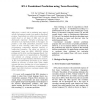31 search results - page 1 / 7 » The Use of Context-Sensitive Grammar For Modeling RNA Pseudo... |
BIOCOMP
2006
13 years 5 months ago
2006
- In this study, a context-sensitive grammar is suggested to model various forms of RNA secondary structures, especially pseudoknots. Comparing with a conventional context-free gra...
CLEIEJ
2006
13 years 4 months ago
2006
Pseudoknots are a frequent RNA structure that assumes essential roles for varied biocatalyst cell's functions. One of the most challenging fields in bioinformatics is the pre...
IJBRA
2006
13 years 4 months ago
2006
: Stochastic Context-Free Grammars (SCFG) has been shown to be effective in modelling RNA secondary structure for searches. Our previous work (Cai et al., 2003) in Stochastic Paral...
BIBE
2005
IEEE
13 years 10 months ago
2005
IEEE
RNA plays a critical role in mediating every step of cellular information transfer from genes to functional proteins. Pseudoknots are widely occurring structural motifs found in a...
CSB
2004
IEEE
13 years 8 months ago
2004
IEEE
Motivation: Since the whole genome sequences for many species are currently available, computational predictions of RNA secondary structures and computational identifications of t...


